Telehealth Reverse Diabetes and End Metabolic Overload
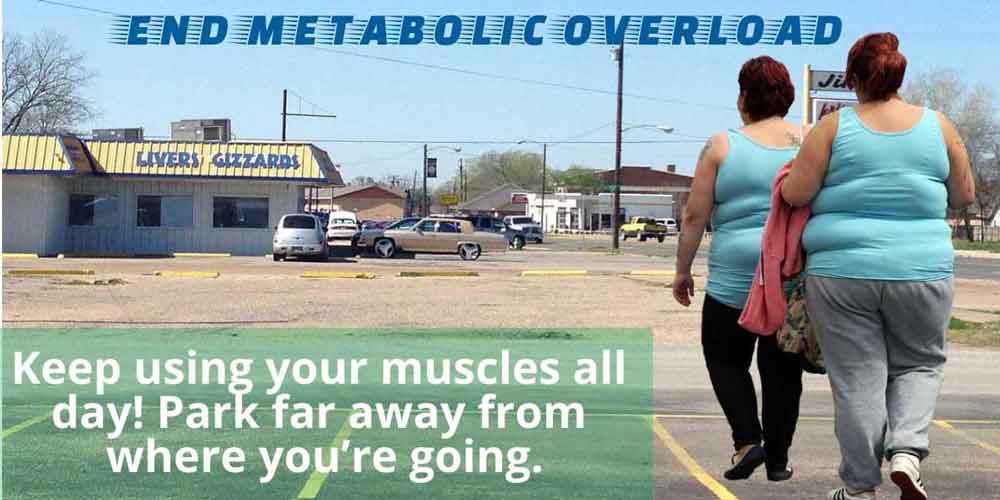
More Calories Consumed than Used increases Body Fat.
Eventually, storing excess fat needs more space.
Expanding fat storage requires a lot more insulin. Otherwise, levels of sugar and fat in the blood get dangerously high.
How to use up calories? How to increase your Metabolism? Keep using your muscles all day! Park far away from where you’re going. Take the stairs.
Call us or contact us and we’ll help you get everything working like it’s supposed to.
Results of Metabolic Overload
Guinness World Records, 2019 lists the heaviest known human weight as 1311 lb. That’s how much a Mexican man weighed in November, 2016. Since then, he has lost almost half his weight down to 669 lb. in November, 2018.
 To keep gaining that much weight requires unique fat cell function and expansion. For most of us, fat tissue spills over into places where it damages organ function. When it expands inside the abdomen, fat tissue there releases fatty acids and secretions directly into the liver causing fatty liver, as well as inflammation, vascular damage and blood clots everywhere.
To keep gaining that much weight requires unique fat cell function and expansion. For most of us, fat tissue spills over into places where it damages organ function. When it expands inside the abdomen, fat tissue there releases fatty acids and secretions directly into the liver causing fatty liver, as well as inflammation, vascular damage and blood clots everywhere.
The increased insulin required to move glucose and fatty acids into fat tissue instead of skeletal muscle also increases fat inside the abdomen.
Metabolic Supply And Demand
When cells are active, they use calories and when they are resting, calories are stored in the cells. When the cells have all the energy they need, they simply stop bringing in glucose, fatty acids and protein from the blood.
During a meal when blood levels are high, liver and fat tissue take in glucose and fatty acids and release them between meals when blood levels are low. At the end of the day, any excess fuel still circulating in the blood moves into fat storage.
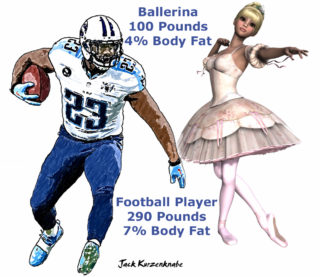
Heavy muscle work can be sustained for hours without much fat tissue. An NFL offensive tackle weighing 290 lb. consumes about 9,000 kcal a day with about 7% of body weight as fat. A ballerina weighing 100 lb. has about 4% body fat. Sustained muscular work has little to do with % body fat.
It doesn’t require much insulin to move glucose, fatty acids and protein into liver and skeletal muscle. When liver and skeletal muscle stores are full, moving them into fat tissue, takes more insulin. High levels of insulin in blood also starts making new fat tissue.
Energy Storage
Storing excess calories is where trouble starts. Some people who are like the Guinness World Record holder keep adding to their subcutaneous fat stores. Most people start storing fat in the abdominal cavity as soon as fat stores increase anywhere. It’s not long until fat increases in liver, pancreas, kidneys, adrenal glands, thyroid, breast tissue, skeletal muscle and heart.
Normal pancreas supplies all the insulin that’s needed and blood levels of glucose and fatty acids stay normal. It’s when pancreas can’t supply enough insulin to control increased levels that the most serious trouble starts.
If glucose and fatty acid levels in blood keep rising, dehydration and acidosis rapidly lead to death. While treating dehydration and acidosis, enough insulin is injected to restore normal storage function.
Fat In The Abdominal Cavity
Men and women with ideal good health, weigh 2 to 2½ lb. per inch of their standing height. They also have skeletal muscle weighing at least 25% of their total weight. Fat tissue is less than 25%. (Men have about 5% more muscle and 5% less fat than women.) Fat in the abdominal cavity, called “Visceral Fat”, is less than 3% of their total body weight.
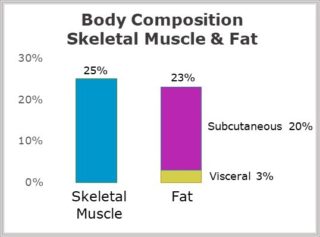 In ideal good health, you have more muscle than fat.
In ideal good health, you have more muscle than fat.
Fat tissue does store twice more calories than muscle. Each pound of pure fat has 4000 kcal while pure protein has 1800 kcal. Both fat tissue and skeletal muscle have mixtures of fat, protein and carbohydrate, but fat tissue stores more than twice as much as muscle.
That’s probably why fat tissue is where all excess calories are stored!
Gaining weight adds more and more fat. Overweight and obese men and women have more fat tissue than muscle. Often more than twice as much!
Worse, still, fat in the Abdominal Cavity (Visceral Fat) increases, pound for pound, about as fast as fat in subcutaneous tissue.
Maximal Waist Circumference
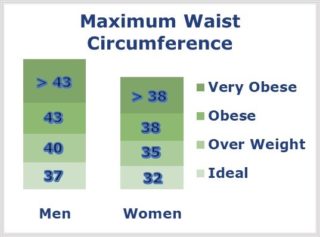 It’s hard to measure exact amounts of fat stored anywhere. However, we do know that good health includes Visceral Fat less than 10% of Total Fat and less than 3% of Total Body Weight. That amount of fat in the abdominal cavity fits inside a Maximum Waist Circumference (maxWC) of 37 inches for Men and 32 inches for Women.
It’s hard to measure exact amounts of fat stored anywhere. However, we do know that good health includes Visceral Fat less than 10% of Total Fat and less than 3% of Total Body Weight. That amount of fat in the abdominal cavity fits inside a Maximum Waist Circumference (maxWC) of 37 inches for Men and 32 inches for Women.
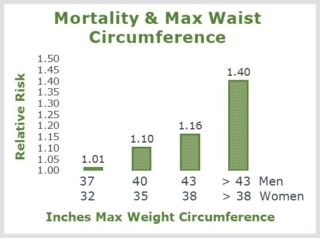 Because we know ideal limits for maxWC, we can test its relation to Risks for developing Diabetes and Risks for Premature Death. Studies with 1400 adults in the US showed that maxWC more than 43 inches doubled the risk of developing Type 2 Diabetes in 7 years. Similar studies with 650,000 adults from several countries showed that max WC more than 43 inches increased risk of Premature Mortality by 40%.
Because we know ideal limits for maxWC, we can test its relation to Risks for developing Diabetes and Risks for Premature Death. Studies with 1400 adults in the US showed that maxWC more than 43 inches doubled the risk of developing Type 2 Diabetes in 7 years. Similar studies with 650,000 adults from several countries showed that max WC more than 43 inches increased risk of Premature Mortality by 40%.
These results indicate that adults 50 years of age with maxWC more than 43 inches for Men and 38 inches for Women lost 5 years of life in good health and died 2½ years prematurely.
Increase Metabolism and Burn Calories
The only sensible way to Increase Metabolism is to increase Using your Skeletal Muscles. The more muscle you have, the more calories you can burn during exercise.
The average adult in good health has about 50 lb of muscle. At rest, all day and all night, that muscle uses about 500 kcal which is about 20 kcal every hour. During 1 hour of moderate exercise like brisk walking, that muscle uses about 250 kcal. That means 50 lb of muscle uses about 20 kcal every hour at rest and about 250 kcal every hour during moderate exercise. More than a 10-fold increase!
The total amount of muscle doesn’t have much effect on metabolism while resting. It does have a substantial effect during moderate exercise walking about 3 mph or 6000 steps in an hour.
Increase Metabolism and Decrease Fat in the Abdominal Cavity
An important benefit of exercise is that it reduces the amount of fat in the abdominal cavity. We know that exercise increases sensitivity to insulin. Probably because exercising muscle needs fuel for energy. When more fuel is needed, muscle cells open up their channels to admit glucose and fatty acids. Insulin becomes more effective. It also acts on adipose tissue to break down fat for fuel. The end result reduces fat in stores everywhere, especially in the abdominal cavity.
The type of exercise doesn’t seem to matter very much. Intensity and duration of effort are what’s important. Endurance exercise probably is more effective than strength training but strength training produces more muscle that can be exercised. Vigorous, sustained exercise is probably more effective than brief, light exercise but increasing total steps during the day is just as effective as brief intense muscular work.
To increase metabolism, build muscle and use it!
Note what happens during exercise when insulin becomes more effective. If you’re injecting insulin or using other medications to control blood sugar, exercise will make levels of blood sugar fall. Especially during vigorous exercise.
You must monitor levels of blood sugar 20 or 30 minutes before exercise, time enough to take some sugar if levels are below 100 mg/dL. Also, you must measure levels every 30 minutes or so during exercise and again after you stop.
Exercise is doing what you want, making insulin more effective as well as burning calories. You just need to anticipate its good effects which include drawing more sugar from your blood during and after exercise!
How Much Fuel You Need For Your Metabolism
 A long time ago, I owned a Volkswagen Beetle. It was a low-cost car with very few conveniences. It didn’t even have much of a heater. On the control panel, there was a speedometer and an odometer. That’s it.
A long time ago, I owned a Volkswagen Beetle. It was a low-cost car with very few conveniences. It didn’t even have much of a heater. On the control panel, there was a speedometer and an odometer. That’s it.
The reason I’m telling this story is that it didn’t have a gas gauge. You knew how fast you were going and how far you’d gone but you didn’t know how much gas you had left.
It had a kick valve that controlled the last cup of gas in the tank. When you ran out of gas, you kicked the lever over to get enough gas to reach a gas station. That was a real nuisance if you were in the fast lane of a highway. It was especially disappointing if you had forgotten to reset the kick valve the last time you filled the tank.
I quickly learned to fill the tank every Saturday even if there was still lots of gas in the tank. Even then, I ran out of gas a couple of times. That’s when I learned to fill the tank every 200 miles.
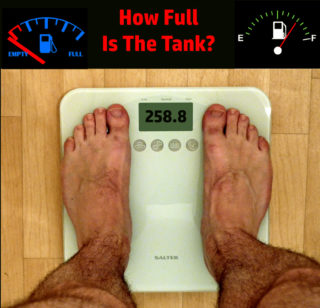 We don’t have a good fuel gauge. As it is, we eat regularly whatever is on our plate. We seldom get really hungry and even then, we don’t think a lot about how much we eat. Probably, we really ought only to eat after every 6000 steps.
We don’t have a good fuel gauge. As it is, we eat regularly whatever is on our plate. We seldom get really hungry and even then, we don’t think a lot about how much we eat. Probably, we really ought only to eat after every 6000 steps.
About all we can do is watch our weight. If you’re gaining weight, you’re eating too much. If your maximum waist circumference is more than 40 inches for a man or 35 inches for a woman, you’ve been eating too much for a long time.
One Small Request:
If you enjoyed reading this article, kindly give it a share. Your share is extremely helpful to spread our message and help more like you.




